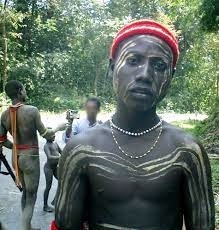Know about Onges tribe origin, facts, history, Religion: The Onges tribe is an indigenous tribal group that inhabits Little Andaman, one of the islands in India’s Andaman and Nicobar Islands. The Onges are a hunter-gatherer society known mainly for their traditional lifestyle and close connection with nature.
The estimated population of the Onges is around 200 individuals, making them one of the smallest tribes in India. They live primarily by hunting and gathering food from the surrounding jungle. The primary food sources for these island dwellers include wild boar, shellfish, honey, crabs, turtles and other small game. Some also supplement their meals with coconuts from nearby trees or wild fruits found in the forest.
Know about Onges tribe origin, facts, history, Religion

Know about Onges tribe origin, facts, history, Religion
- The Onges tribe is an indigenous group located in the Andaman Islands of India.
- They are a hunter-gatherer society and have maintained their traditional lifestyle for centuries.
- The Onges language is unique and is not related to any other language.
- Their population has remained small, hovering around 100 people, with some estimates as low as 55 members.
- The Onges are known to practice rituals such as bathing in sacred waters and performing rites of passage on teens that involve walking underwater between two islands.
- They also practice a form of sustainable hunting, using blowpipes and arrows with poison extracted from plants to hunt various animals such as wild pigs.
- The Onges are very vulnerable to external threats and have faced numerous attempts at contact with outsiders, some of which resulted in the spread of infectious diseases that decimated a large portion of their population.
- The Onges have been granted legal protection by India’s government and efforts are being made to preserve their culture through various conservation projects.
- In recent years, the Indian government has taken steps to create a buffer zone around the Andaman Islands in order to protect the Onges tribe from further encroachment.
- The Onges remain relatively isolated from the outside world and are determined to maintain their traditional lifestyle for generations to come.
- They serve as an example of the importance of preserving indigenous cultures and protecting their rights.
In recent years, the Onges tribe has become more visible in the global community and is a symbol of hope for many indigenous peoples.
The Onges demonstrate that it is possible to preserve their culture and unique identity while still participating in the modern world.
Unique Facts about Onges tribe
- The Onges are an Indigenous group located on the Andaman Islands of India that have maintained their traditional lifestyle for centuries.
- They practice rituals such as bathing in sacred waters and sustainable hunting with blowpipes and arrows with poison extracted from plants.
- The Onges have faced various external threats including attempts at contact by outsiders which resulted in spread of infectious diseases that decimated a large portion of their population.
- In recent years, the Indian government has taken steps to create a buffer zone around the Andaman Islands in order to protect the Onges tribe from further encroachment.
- The Onges serve as an example of the importance of preserving indigenous cultures and protecting their rights.
- They demonstrate that it is possible to preserve their culture and unique identity while still participating in the modern world.
- The Onges are a symbol of hope for many Indigenous peoples.
